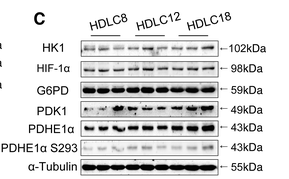Phospho-PDHA1/2 (Ser293/Ser291) Antibody - #AF8502
| Product: | Phospho-PDHA1/2 (Ser293/Ser291) Antibody |
| Catalog: | AF8502 |
| Description: | Rabbit polyclonal antibody to Phospho-PDHA1/2 (Ser293/Ser291) |
| Application: | WB IHC IF/ICC |
| Cited expt.: | WB, IF/ICC |
| Reactivity: | Human, Mouse, Rat |
| Prediction: | Pig, Bovine, Horse, Sheep, Rabbit, Chicken, Xenopus |
| Mol.Wt.: | 43 kDa; 43kD(Calculated). |
| Uniprot: | P08559 | P29803 |
| RRID: | AB_2840556 |
Related Downloads
Protocols
Product Info
*The optimal dilutions should be determined by the end user. For optimal experimental results, antibody reuse is not recommended.
*Tips:
WB: For western blot detection of denatured protein samples. IHC: For immunohistochemical detection of paraffin sections (IHC-p) or frozen sections (IHC-f) of tissue samples. IF/ICC: For immunofluorescence detection of cell samples. ELISA(peptide): For ELISA detection of antigenic peptide.
Cite Format: Affinity Biosciences Cat# AF8502, RRID:AB_2840556.
Fold/Unfold
ODPA_HUMAN; PDH; PDHA; PDHA1; PDHCE1A; PDHE1 A type I; PDHE1-A type I; PHE1A; Pyruvate Dehydrogenase (lipoamide) alpha 1; Pyruvate dehydrogenase complex, E1 alpha polypeptide 1; Pyruvate Dehydrogenase E1 alpha; Pyruvate dehydrogenase E1 component subunit alpha, somatic form, mitochondrial; EC 1.2.4.1; MGC149517; MGC149518; mitochondrial; ODPAT_HUMAN; Pdha2; PDHAL; PDHE1 A type II; PDHE1-A type II; Pyruvate dehydrogenase (lipoamide) alpha 2; Pyruvate dehydrogenase E1 component subunit alpha; Pyruvate dehydrogenase E1 component subunit alpha, testis specific form, mitochondrial; Pyruvate dehydrogenase, E1 alpha polypeptide, testis spec; testis-specific form;
Immunogens
A synthesized peptide derived from human PDHA1/2 around the phosphorylation site of Ser293/291.
Ubiquitous.
P29803 ODPAT_HUMAN:Testis. Expressed in postmeiotic spermatogenic cells.
- P08559 ODPA_HUMAN:
- Protein BLAST With
- NCBI/
- ExPASy/
- Uniprot
MRKMLAAVSRVLSGASQKPASRVLVASRNFANDATFEIKKCDLHRLEEGPPVTTVLTREDGLKYYRMMQTVRRMELKADQLYKQKIIRGFCHLCDGQEACCVGLEAGINPTDHLITAYRAHGFTFTRGLSVREILAELTGRKGGCAKGKGGSMHMYAKNFYGGNGIVGAQVPLGAGIALACKYNGKDEVCLTLYGDGAANQGQIFEAYNMAALWKLPCIFICENNRYGMGTSVERAAASTDYYKRGDFIPGLRVDGMDILCVREATRFAAAYCRSGKGPILMELQTYRYHGHSMSDPGVSYRTREEIQEVRSKSDPIMLLKDRMVNSNLASVEELKEIDVEVRKEIEDAAQFATADPEPPLEELGYHIYSSDPPFEVRGANQWIKFKSVS
- P29803 ODPAT_HUMAN:
- Protein BLAST With
- NCBI/
- ExPASy/
- Uniprot
MLAAFISRVLRRVAQKSARRVLVASRNSSNDATFEIKKCDLYLLEEGPPVTTVLTRAEGLKYYRMMLTVRRMELKADQLYKQKFIRGFCHLCDGQEACCVGLEAGINPSDHVITSYRAHGVCYTRGLSVRSILAELTGRRGGCAKGKGGSMHMYTKNFYGGNGIVGAQGPLGAGIALACKYKGNDEICLTLYGDGAANQGQIAEAFNMAALWKLPCVFICENNLYGMGTSTERAAASPDYYKRGNFIPGLKVDGMDVLCVREATKFAANYCRSGKGPILMELQTYRYHGHSMSDPGVSYRTREEIQEVRSKRDPIIILQDRMVNSKLATVEELKEIGAEVRKEIDDAAQFATTDPEPHLEELGHHIYSSDSSFEVRGANPWIKFKSVS
Predictions
Score>80(red) has high confidence and is suggested to be used for WB detection. *The prediction model is mainly based on the alignment of immunogen sequences, the results are for reference only, not as the basis of quality assurance.
High(score>80) Medium(80>score>50) Low(score<50) No confidence
Research Backgrounds
The pyruvate dehydrogenase complex catalyzes the overall conversion of pyruvate to acetyl-CoA and CO(2), and thereby links the glycolytic pathway to the tricarboxylic cycle.
Phosphorylation at Ser-232, Ser-293 and Ser-300 by PDK family kinases inactivates the enzyme; for this phosphorylation at a single site is sufficient. Dephosphorylation at all three sites, i.e. at Ser-232, Ser-293 and Ser-300, is required for reactivation.
Acetylation alters the phosphorylation pattern. Deacetylated by SIRT3 (By similarity).
Mitochondrion matrix.
Ubiquitous.
The pyruvate dehydrogenase complex catalyzes the overall conversion of pyruvate to acetyl-CoA and CO(2), and thereby links the glycolytic pathway to the tricarboxylic cycle.
Phosphorylation at Ser-291, Ser-293 and Ser-298 by PDK family kinases inactivates the enzyme; for this phosphorylation at a single site is sufficient. Phosphorylation at Ser-293 interferes with access to active site, and thereby inactivates the enzyme. Dephosphorylation at all three sites, i.e. at Ser-291, Ser-293 and Ser-298, is required for reactivation.
Mitochondrion matrix.
Testis. Expressed in postmeiotic spermatogenic cells.
Research Fields
· Environmental Information Processing > Signal transduction > HIF-1 signaling pathway. (View pathway)
· Human Diseases > Cancers: Overview > Central carbon metabolism in cancer. (View pathway)
· Metabolism > Carbohydrate metabolism > Glycolysis / Gluconeogenesis.
· Metabolism > Carbohydrate metabolism > Citrate cycle (TCA cycle).
· Metabolism > Carbohydrate metabolism > Pyruvate metabolism.
· Metabolism > Global and overview maps > Metabolic pathways.
· Metabolism > Global and overview maps > Carbon metabolism.
· Organismal Systems > Endocrine system > Glucagon signaling pathway.
References
Application: WB Species: bovine Sample:
Application: IF/ICC Species: bovine Sample:
Application: WB Species: chicken Sample:
Restrictive clause
Affinity Biosciences tests all products strictly. Citations are provided as a resource for additional applications that have not been validated by Affinity Biosciences. Please choose the appropriate format for each application and consult Materials and Methods sections for additional details about the use of any product in these publications.
For Research Use Only.
Not for use in diagnostic or therapeutic procedures. Not for resale. Not for distribution without written consent. Affinity Biosciences will not be held responsible for patent infringement or other violations that may occur with the use of our products. Affinity Biosciences, Affinity Biosciences Logo and all other trademarks are the property of Affinity Biosciences LTD.












